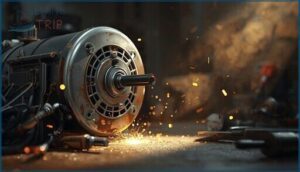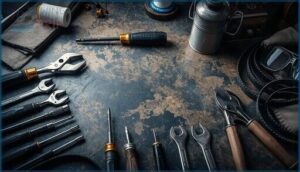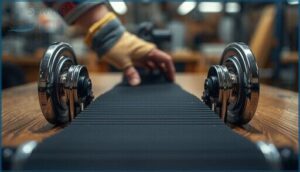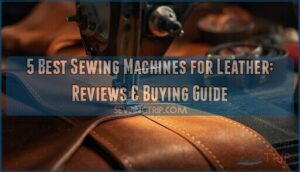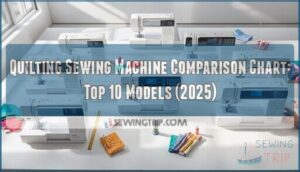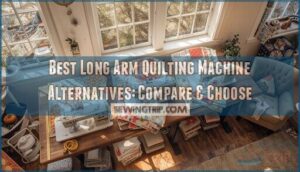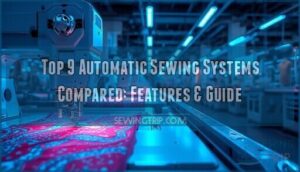This site is supported by our readers. We may earn a commission, at no cost to you, if you purchase through links.
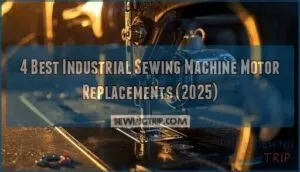
Most factory operators don’t think about their motor until it dies, but here’s what the pros know: replacing a failing clutch motor with a modern servo can slash your energy bills by 70% while eliminating that constant hum that’s been rattling your workspace for years.
The right replacement motor doesn’t just get you back online—it transforms how your machine performs, how much power it draws, and how long you can run between maintenance calls.
Table Of Contents
Key Takeaways
- Replacing an old clutch motor with a modern servo motor cuts energy consumption by 60-80%, dramatically lowers noise levels (idle drops to under 20 dB compared to 50+ dB), and provides precise speed control from 100 to 6,000 RPM without constant spinning.
- Servo and brushless motors only draw power when you’re actively sewing—unlike clutch motors that burn electricity continuously—which translates to measurable cost savings of $100-170 annually while reducing workplace vibration and fatigue.
- Before buying a replacement motor, verify four critical specs: voltage compatibility (110V or 220V), horsepower requirements (typically 0.5-1 HP), mounting plate dimensions, and belt pulley diameter to avoid expensive mismatches during installation.
- Replace your motor when you notice grinding noises, overheating, reduced speed, or burning smells—waiting for total failure creates costly downtime, while proactive replacement lets you plan the upgrade on your terms.
Top 4 Industrial Sewing Machine Motors Worth Buying
Choosing the right replacement motor can feel like picking the right tool for a job—get it right, and everything runs smooth.
The motors below cover different needs, from quiet operation to energy savings, so you can match one to your workspace.
Here’s what’s worth your attention.
1. Servo Motor Sewing Machine Silent

Silent servo motors have changed how industrial sewing machine shops operate. These motors drop ambient noise below 20 dB when you’re not sewing, compared to over 50 dB from old clutch motors. During active work, you’ll hear around 65 dB—that’s 8 to 15 dB quieter than clutch setups.
Vibration dampening makes a big difference too. When you upgrade to a servo motor with proper motor enclosures and soundproofing options, your workplace comfort improves dramatically.
You’ll notice the change right away: no constant hum, less fatigue, and better focus on precision work.
Best For: Industrial sewing operators and small factories looking to cut noise levels, save energy, and gain precise speed control without replacing their entire machine setup.
- Cuts noise dramatically—idle runs near-silent (under 20 dB) and sewing drops to around 65 dB, much quieter than clutch motors that hit over 50 dB at rest
- Slashes energy costs by 45–80% since the motor only runs when you press the pedal, compared to clutch motors that spin constantly
- Gives you precise speed control from 400 to 4000 RPM with needle positioning accuracy within 1 degree, perfect for delicate fabrics or thick leather
- Installation might need extra parts like a new belt or needle sensor, and some setups require digging into YouTube tutorials or technical know-how
- Build quality varies—some users report average construction that could be better for the price
- Limited guidance for certain machine types means you may need to experiment or research compatibility on your own
2. Industrial Sewing Machine Servo Motor

A quality servo motor transforms your industrial sewing machine into a precision tool. You’ll control speed from 100 to 6,000 RPM with just your foot pedal pressure—no constant spinning like old clutch motors.
Modern servo motor benefits include 60% to 80% energy savings and better stitch quality on heavy fabrics. Market adoption has surged because brushless technology trends deliver less maintenance and longer life.
When you’re not sewing, power draw drops to about 1W. That motor upgrade pays for itself through lower electricity bills and improved performance control across leather, upholstery, and industrial applications.
Best For: Industrial sewers, upholstery shops, and leather workers who need precise speed control and want to cut energy costs while upgrading from outdated clutch motors.
- Saves 60% to 80% on electricity compared to clutch motors, with standby draw at just 1W
- Precise speed control from 100 to 6,000 RPM lets you handle delicate details or power through heavy materials
- Brushless design means less maintenance and longer lifespan without replacing brushes
- Installation isn’t always plug-and-play—you might need custom mounting or a new belt
- Setup instructions for speed adjustments can be unclear
- Quality varies, with some users reporting average build compared to premium brands
3. Consew Servo Motor Industrial Sewing Machine
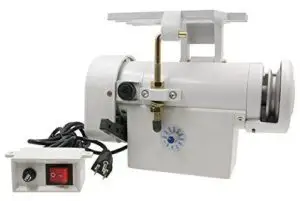
The Consew servo motor packs 3/4 horsepower into a 17-pound steel body that fits most industrial sewing machine motors. You get a rotary dial for speed adjustments, from low precision work up to full throttle, plus a brake feature that stops the needle exactly where you need it.
Installation takes minimal effort—the 75mm pulley and 13mm shaft match standard setups, though you might swap your belt for a 1000mm size. Brake performance keeps you safe during fabric positioning.
Noise levels drop noticeably compared to clutch motors, and this motor upgrade delivers the energy efficiency you’d expect from modern servo technology.
Best For: Industrial sewers and upholstery professionals who want precise speed control, quieter operation, and energy savings over traditional clutch motors.
- Adjustable speed dial with brake feature lets you stop the needle exactly where needed for safer, more precise work
- Significantly quieter and more energy-efficient than clutch motors while delivering smooth 3/4hp performance
- Easy installation with standard 75mm pulley and 13mm shaft that fits most industrial machines, plus includes spare brake pad and motor brushes
- Speed dial uses detents rather than infinite adjustment, limiting fine-tuning options
- May require purchasing a compatible belt (often 1000mm) separately for proper fit
- Durability varies with usage intensity and maintenance—longevity isn’t guaranteed for heavy commercial use
4. Sewing Machine Servo Motor Energy Efficient
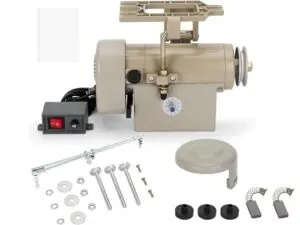
This 550W servo motor cuts your energy bill roughly in half compared to old clutch motors, which translates to real operational cost benefits over time. The motor only runs when your foot hits the pedal, unlike clutch motors that burn electricity nonstop.
You’re not just saving money—you’re shrinking your shop’s carbon footprint while getting quieter operation. That means productivity gains through better speed control for detailed work, plus workplace noise reduction that makes long shifts easier on everyone.
Energy efficiency meets practical performance in one straightforward motor replacement.
Best For: Garment factories, tailoring shops, and industrial sewing operations looking to cut energy costs while improving speed control for detailed stitching work.
- Cuts energy consumption by roughly 50% compared to clutch motors since it only runs when the pedal is engaged, leading to measurable operational cost savings
- Delivers precise speed control and quieter operation, making detailed work easier and reducing workplace noise during long shifts
- Simple installation with included hardware (mounting bolts, damper, belt cover, switch, extra brushes) and compatibility across multiple industrial machine types
- Limited slower speed options and pulley choices may restrict fine-tuning for ultra-detailed work requiring minimal stitch speed
- Durability and lifespan data aren’t widely documented, creating uncertainty about long-term performance and replacement timing
- Installation and maintenance may require technical knowledge, potentially adding setup costs for shops without in-house expertise
Clutch Vs. Servo Vs. Brushless Motors
Choosing the right motor type determines how your machine performs and how much power it consumes. Clutch motors have been the industry standard for decades, but servo and brushless options offer different trade-offs in control, noise, and efficiency.
Here’s what sets each motor type apart.
How Clutch Motors Work
Clutch motors run constantly when you flip the power switch, spinning away like an engine at idle until you press the pedal to engage the needle. This design creates heat and burns energy even when you’re not stitching. Speed control comes from how hard you push the pedal, but stopping requires a mechanical brake that wears down over time.
| Feature | How It Works | Common Issues |
|---|---|---|
| Power State | Motor spins continuously once switched on | High energy consumption, constant noise |
| Speed Control | Pedal pressure adjusts clutch engagement | Limited precision at slow speeds |
| Braking System | Mechanical brake stops needle position | Brake pads wear out, require regular replacement |
| Vibration Level | Constant rotation creates steady vibration | Increases fatigue during long sessions |
| Starting Torque | Belt-driven clutch engagement provides power | Belt slippage when working with heavy fabrics |
Servo Motor Advantages and Performance
When you press the pedal on a servo motor, it springs to life instantly—then goes completely silent the moment you lift your foot. This on-demand operation delivers serious energy savings and noise reduction compared to clutch motors. You’ll notice better speed control at slow stitching rates and less vibration dampening your workspace comfort.
| Feature | Servo Motor Performance |
|---|---|
| Torque Efficiency | More torque per horsepower gives you power through thick layers without belt slippage |
| Energy Consumption | Runs only when pedal engages—cuts electricity use by 60-70% compared to clutch motors |
| Precision Control | Adjustable sewing speeds from single-stitch crawl to full RPM with smooth acceleration |
Brushless Motor Benefits
If you’re chasing quieter operation and lighter weight without sacrificing power, brushless motors deliver exactly that upgrade path. They’re smaller, easier to install, and spin at higher RPMs with reduced vibration that keeps your workspace calm. You’ll also gain precise control through thick materials without the maintenance headaches of brush replacement.
| Feature | Brushless Motor Advantage |
|---|---|
| Quiet Operation | Minimal noise during full-speed runs |
| Compact Design | Lighter and smaller than servo motors |
| Reduced Vibration | Smoother stitching with less machine shake |
| Enhanced Durability | No brushes means fewer parts to replace |
| Precise Control | Consistent torque across all speed ranges |
Energy Consumption Comparison
Your electricity bill shrinks dramatically when you swap that old clutch motor for a servo or brushless model. Clutch motors burn power continuously while idling, but modern options only draw current when you’re actually stitching. This shift in usage patterns slashes energy consumption by up to 70%, delivering measurable cost savings and reducing your shop’s environmental impact while boosting motor efficiency across the board.
Swapping to a servo or brushless motor cuts energy use up to 70% since it only runs while stitching, unlike clutch motors that idle constantly
For sewing faux leather, consider using a leather needle to guarantee clean cuts.
| Motor Type | Power Consumption (Idle) | Power Consumption (Active) | Annual Energy Cost* |
|---|---|---|---|
| Clutch Motor | 250-400W continuous | 550-750W | $180-$240 |
| Servo Motor | 10-20W standby | 400-550W | $50-$80 |
| Brushless Motor | 5-15W standby | 350-500W | $40-$70 |
*Based on 2,000 hours/year at $0.12/kWh
When to Replace Your Industrial Motor
Your motor won’t last forever, and knowing when to upgrade can save you from unexpected breakdowns. Recognizing the warning signs early helps you plan ahead instead of scrambling for repairs mid-project.
Here’s what to watch for so you can replace your motor on your terms, not when it forces your hand.
Signs Your Motor Needs Replacement
Your industrial sewing machine motor doesn’t usually give you a warning before it fails—but if you know what to listen for, you can catch problems before they shut down your entire operation. Unusual noises like grinding or rattling signal wear and tear inside the motor.
Reduced speed, overheating motor issues, or a burning smell mean you need sewing machine repair fast. When stitch quality drops unexpectedly, your industrial sewing machine replacement motor might be failing.
Don’t wait—replacing sewing machine motors before total failure saves you downtime and money.
Maintenance Schedule and Inspection Guidelines
Regular inspections catch small problems before they turn into expensive breakdowns, and most industrial motors need attention every 500 to 1,000 hours of use. Check motor lubrication and inspect brushes during these intervals to prevent wear and tear.
Performance monitoring helps you spot power drops early, while preventative maintenance keeps your machine running smoothly.
A solid troubleshooting guide makes sewing machine repair easier when issues appear.
Expected Lifespan of Different Motor Types
Knowing when motors usually wear out helps you plan replacements and avoid downtime. Different motor types have distinct lifespans based on their design and duty cycles.
- Clutch motor lifespan ranges from 5 to 10 years under regular industrial use, though continuous operation increases wear
- Servo motor durability delivers 20,000 to 30,000 hours of bearing life, exceeding 10 years with moderate use
- Brushless motor longevity surpasses 30,000 hours, lasting up to 50% longer than brushed designs
- Lifespan factors include temperature extremes, moisture exposure, ventilation quality, and maintenance frequency
- Predictive maintenance through routine inspections maximizes motor life and prevents unexpected failures
High-quality industrial sewing machine motors with proper care can last 10 to 20 years. Direct drive motors improve efficiency by eliminating belts and gears.
Cost Breakdown for Repair Vs. Replacement
Understanding repair cost factors helps you decide whether to fix or replace your motor. Standard repairs run $80 to $100 per hour, with most jobs taking one to two hours. A full tune-up costs $200 to $300. Replacement payback period averages one to three years when factoring in energy savings from modern servo motors, which reduce power use by 70%. Vintage model costs can jump 50% higher due to rare parts.
| Cost Factor | Repair | Replacement |
|---|---|---|
| Labor | $80–$100/hour | $80–$100 installation |
| Parts | $5+ per component | $100–$200 servo motor |
| Total Average | $160–$300 | $200–$350 complete |
| Energy Savings | None | Up to 70% reduction |
| Warranty Cost Savings | Limited coverage | 1–3 years protection |
Replace when repair costs exceed 50% of a new machine’s cost. Entry-level industrial sewing machines start at $1,000.
How to Choose The Right Replacement Motor
Picking the right replacement motor isn’t about grabbing the first one that fits. You need to match your machine’s requirements and your workspace needs.
Here’s what to check before you buy.
Matching Motor Specs to Your Machine
Before you drop a single dollar on a replacement motor, check your machine’s voltage rating and mounting configuration to avoid an expensive mismatch.
Most industrial sewing machine replacement motors need these four specs to line up:
- Voltage compatibility (110V or 220V matches your outlet)
- Horsepower needs (commonly 0.5–1 HP for standard work)
- Phase requirements (single-phase for most shops)
- Frame size and pulley diameter (guarantees proper belt alignment)
Double-check your motor specifications before ordering.
Torque and RPM Requirements
Once voltage and horsepower match up, focus on torque and RPM to address your fabric weight and speed control needs. Heavy materials like canvas or leather demand higher torque at lower speeds, while lightweight fabrics benefit from smoother RPM ranges above 3,000.
Servo motors excel here because they deliver consistent motor power across different application needs without sacrificing stitch quality—critical when precision matters most on your industrial sewing machine.
Installation Compatibility Considerations
Check your motor’s mounting plate and belt pulley dimensions before you buy—even “universal” motors won’t fit if the base holes or pulley diameter don’t line up with your machine’s existing setup. Most industrial sewing machine replacement motors use standard mounting dimensions, but older machines may need adapters.
Verify these compatibility points:
- Voltage requirements and wiring harnesses must match your power supply—110V versus 220V systems aren’t interchangeable without electrical modifications
- Control box and pedal linkage connections should align with your existing setup to avoid rewiring complications during sewing machine motor replacement
- Belt pulley diameter affects speed ratios—mismatched sizes compromise stitch consistency and motor performance on industrial sewing machine equipment
Noise Level and Workspace Factors
If you’re working in a shared space or running production for hours at a time, motor noise can turn your workspace into an exhausting environment—and that’s where modern motors make a real difference.
Servo and brushless motors run quieter than clutch systems because they stop completely when you’re not sewing. That reduces noise level and vibration dampening needs in your workroom environment.
Lower motor power draw also means less heat buildup, which improves ergonomic impact during long sessions on your industrial sewing machine.
Installing Your New Sewing Machine Motor
Installing a new motor isn’t as complicated as it sounds, but you’ll need the right tools and a clear process to get it done right. The key is working methodically through each step and making sure your belt sits just right.
Let’s walk through what you need and how to make the swap without any headaches.
Tools and Parts You’ll Need
You’ll need just a handful of basic tools and parts to swap out your industrial motor—nothing fancy, and most of it’s probably already in your toolbox.
Grab essential screwdrivers and a pliers variety for removing metal components. Have the correct belt sizes on hand for your sewing machine motors.
You’ll also want oiling equipment for lubrication and safety goggles to protect your eyes when working around industrial equipment.
Step-by-Step Installation Process
Start by disconnecting the power—always cut the electricity before touching anything, or you’re risking a serious shock.
During motor disassembly, remove the old motor by loosening the mounting bolts and disconnecting wiring connections.
Position your new sewing machine motor, making sure of proper pulley alignment with the handwheel. Secure mounting bolts, reconnect wires following manufacturer specs, and perform testing functionality before full operation.
Belt Tension and Alignment Tips
A loose or misaligned belt will rob your machine of power and ruin stitches before you even notice what’s wrong. Here’s how to get it right:
- Check best tension by pressing the belt midway—it should deflect about half an inch
- Align pulleys so belt runs straight without wobbling or riding up the sides
- Inspect belt material for cracks or glazing that reduce grip on industrial sewing machines
- Measure tension with a gauge if available, targeting manufacturer specifications for your sewing machine motors
- Reduce vibration through proper alignment, extending motor lifespan and improving stitch quality
Frequently Asked Questions (FAQs)
Can I upgrade any industrial machine motor model?
Most replacement motors work with any industrial machine, but you’ll want to verify voltage compatibility and mount configuration first. Universal motor mounts accommodate most setups, though control system integration and customization options vary by model.
Upgrading sewing machine equipment usually succeeds across different sewing machine motor types.
What warranty coverage applies to replacement motors?
Most replacement motors include a one-year manufacturer warranty covering defects and workmanship. Coverage details vary by brand, but typical exclusions include improper installation, misuse, or normal wear.
Check product reviews of commercial sewing machine motors to understand claim processes and whether extended warranties suit your needs.
How do I dispose of my old motor?
Contact your local recycling center about Sewing Motors and electronic motor disposal. Clutch motors and brushless motor units may contain hazardous waste materials. Some facilities offer Component Salvage programs.
Proper Safe Disposal protects the Environmental Impact. Recycling Options vary by Motor Features and location.
Will changing motors affect my machines warranty?
Modifying motors might impact warranty validity depending on manufacturer terms and dealer policies.
Most industrial machines allow motor swaps without warranty voidance, but verify your specific coverage before making motor modifications to avoid legal implications.
Conclusion
Your next industrial sewing machine motor replacement isn’t just a fix—it’s a major improvement that’ll transform your entire operation. The motor you choose determines whether you’re burning cash on electricity or pocketing the savings.
Servo motors cut energy costs dramatically while running whisper-quiet compared to those old clutch beasts. Match your machine’s torque requirements, check the mounting specs, and you’ll be back to full production faster than you thought possible.
Don’t wait for another breakdown to force your hand.
- https://www.anysew.com/blog/what-are-the-most-common-industrial-sewing-machine-parts-that-need-replacing
- https://gesrepair.com/motor-failure-statistics-you-need-to-know/
- https://www.scribd.com/document/850088288/Lifespan-of-Industrial-Machinery
- https://www.youtube.com/watch?v=BOkxzoxcxqM
- https://industrialautomationco.com/blogs/news/the-real-cost-of-downtime-how-a-spare-parts-strategy-saves-you-thousands

